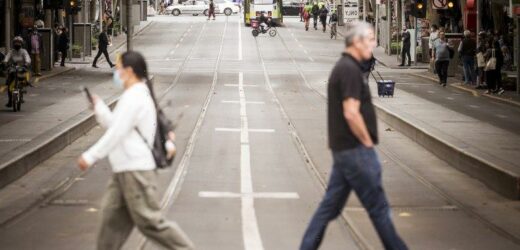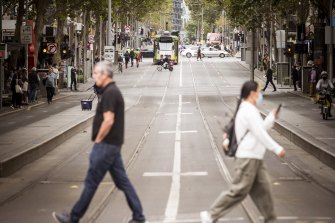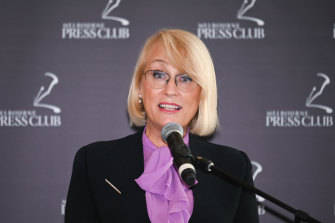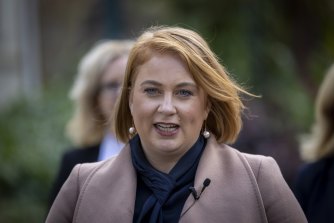The number of workers visiting offices in Melbourne’s CBD rose above 30 per cent of the pre-pandemic rate in March, but occupancy is still as low as 17 per cent on quiet days, primarily Monday and Friday.
The latest data from the Property Council of Australia found average office attendance increased from 15 per cent of pre-pandemic rates in February to 32 per cent last month.
More workers returned to Melbourne’s CBD in March, but on some days office occupancy remains low.Credit:Chris Hopkins
CBD workplaces in the Victorian capital remain the least-attended nationwide, with Sydney ahead at 41 per cent and Adelaide leading at 61 per cent.
The survey of property owners found office occupancy in Melbourne reached a maximum of 38 per cent on peak days. On the quietest days, just 17 per cent, or fewer than one in five workers who visited the city before the pandemic, were in the CBD.
Lord mayor Sally Capp admitted her council faced a big task making the city lively every day of the week, and she suggested the make-up of workers and visitors to the CBD would become more diverse in coming months once the routine of office workers became established.
“For our little traders, they’re paying seven days a week of rent, seven days of labour, seven days of utilities. And we need to make sure they’ve got seven days’ worth of customers,” Cr Capp said at a Melbourne Press Club “bringing Melbourne back” event on Wednesday.
Although average office occupancy surpassed 30 per cent in March for the first time since May last year, the lord mayor said foot traffic was still drastically down on Mondays and Fridays as desk workers opted to stay at home.
Renewing calls from last year, Cr Capp said she would “absolutely love it” if Premier Daniel Andrews ordered the state’s nearly 60,000 public servants back to the office at least three days a week.
“That would be fantastic. We also understand the role that flexible working plays as we move forward,” she said, adding about 30 per cent of Melbourne City Council’s office staff were working from home on average.
Danni Hunter, the Property Council’s Victorian executive director, said staff recognised the value of in-person work for creativity and spontaneous interaction.
Lord mayor Sally Capp speaks at Melbourne Press Club on Wednesday. She says foot traffic is low on Mondays and Fridays in the CBD.Credit:Eddie Jim
She said she expected Friday office attendance to pick up over the next month with the AFL season under way and hospitality venues reporting high demand on Friday nights.
“Mondays are a problem,” she said. “You’ve got a lot of offices putting on free breakfast, drinks, asking really interesting people to come in and speak. But it’s obviously not having the impact.”
Amid suggestions from urban planners that unused office space should be converted into creative hubs, Ms Hunter said the owners of second- and third-tier-quality buildings in particular should consider the option.
Cr Capp said she could see creative workers making up a greater proportion of CBD workers in the coming months, alongside small- and medium-sized businesses that she said were in “hustle mode, looking for spaces”.
The Property Council of Australia’s Victorian executive director Danni Hunter.Credit:Wayne Taylor
“At better pricing, there’s no doubt. But pre-COVID, we were basically zero vacancy in the city for office space, and now of course people are looking for those opportunities,” she said.
“Once we start to settle into a new rhythm for what was a pre-COVID workforce and we understand what spaces, even crevasses, are available, then we’re able to really support more people into those spaces. It certainly seems like the demand is there.
“The mix will be different, but that can be a very positive thing as well.”
The Property Council survey also found many owners have lost their early-year confidence that there will be a material increase in office attendance in the short term.
In January, more than half of Property Council members expected a boost in the next one to two months, which the latest data indicates has not eventuated. More than half in the most recent survey now expect it will be three months or longer before a material increase occurs.
The Morning Edition newsletter is our guide to the day’s most important and interesting stories, analysis and insights. Sign up here.
Most Viewed in National
From our partners
Source: Read Full Article




